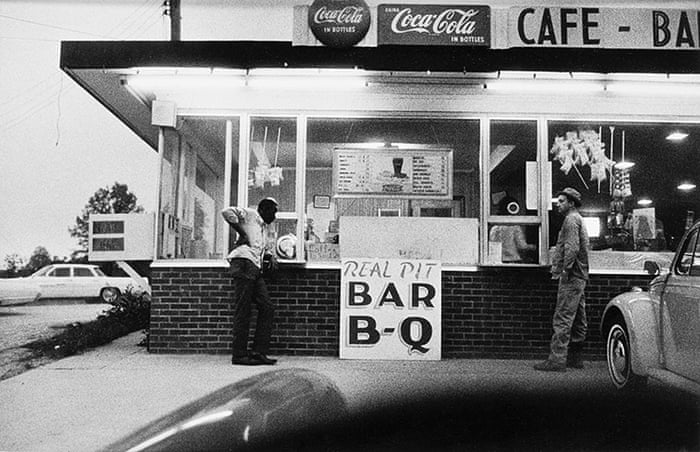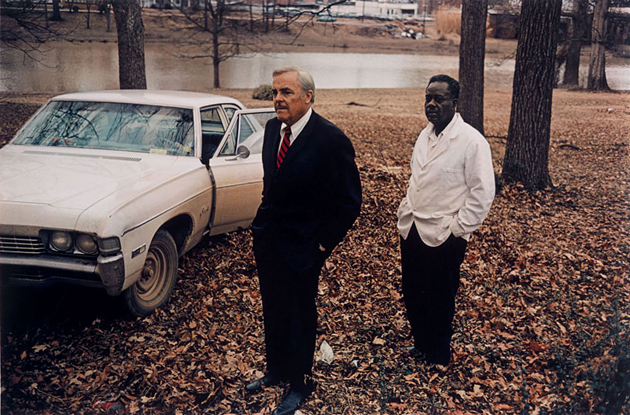 |
| William Eggleston, Untitled (A Cafe in Memphis), Memphis, c. 1968 |
The epigram to the catalogue’s main essay
quotes Eggleston: “I think of them as parts of a novel I’m doing.” The
quotation finds Eggleston reflecting on his series of photographs, as though
next to each other, the narrative unfolds. As I wandered this small, but rich,
selection of Eggleston’s work I was fascinated to see that each image tells a
story, each image contains a long, and often mysterious, narrative that begins
with the suggestions in the image and continues in the viewer’s imagination. Even
before they are put in their series, within each frame, there is a story to be
told. And if we recognize early on the debt owed to Eggleston by photographers
such as Andreas Gursky and Thomas Ruff, what the contemporary photographers
don’t do is also very clear.
 |
| William Eggleston, Untitled (Sumner, Mississippi, Cassidy Bayou in Background) 2011 |
Eggleston’s photographs tell stories in a
way that photography in a post-photographic world does not. A man’s hand
picking something off the ground reflected in the fender of a car, a black man
and a white man standing together in what looks like a remote location, a car
with its door still open behind them, or an old man sitting on bed with a gun
at his finger tips. All these images are swelling with a story that’s not yet
told. All these images hold us before
them, conjuring up the narratives that have led to the moment Eggleston finds
in the image. In other photographs, the mystery is ignited and the story begun
through the framing. It’s rare that Eggleston includes the whole object in the
image, mostly it’s parts of objects, places, even people, that come into his
frame to create textures, shapes, patterns, and thus, to give them a before and
an after. Our imaginations are tempted.
 |
| William Eggleston, From Los Alamos Folio 1, Memphis (supermarket boy with carts), 1965 |
So much of what Eggleston is doing, so much
of what makes these works not possible in today’s post-photographic world lies
in the materials of his art. Everything in these photographs begins with the
richness and materiality of their color. The color is not only vibrant and clear,
but the colors themselves are unusual for today’s viewers. The pinks and
yellows and cobalt blues are the result of Eggleston’s use of the dye transfer
process. A boy pushing shopping trolleys, a woman in the car with her children,
even a television bathed in the yellow light of the setting sun are so rich
that on seeing the photographs, it’s as though Eggleston discovers the
existence of this magical hour of the day. The yellows, pinks, greens are
bright, intense, deeply saturated and with not a trace of disintegration over
the years. Eggleston discovered the dye transfer process in the early 1970s as
a printing process that would allow for the reproduction of intense colors: in
its original use for advertising, the brighter the color, the more attractive
the product. Eggleston takes uniqueness of dye transfer—its larger color gamut
and tonal scale than any other process—and sees the world through its possibilities.
Again, it’s as if the world he discovers did not exist before he saw it through
the lens of his photographic process.
 |
| William Eggleston, From Dust Bells, Vol 1 Memphis, c. 1965-68 |
But it’s not all process, because Eggleston’s
photographs are anything but advertising. It’s something to do with the fact
that the places and spaces, the objects and even the people are rarely
photographed in their entirety. Composition is of utmost importance to the
poignancy and odd simultaneity of mystery in these photographs. Similarly, he
points his camera at the decay that he finds on the streets of the 1970s
American South. The overwhelming sense of decay to the places and objects and
surfaces that fill these photographs put them at a remove from the advertising
images for which the dye transfer process was made.
 |
| William Eggleston, From Los Alamos, Folio 4 Louisiana, c. 1971-74 |
The images are everywhere about the
American South. When a black man and a white man lean at two different service
windows of the same Real Pit Bar B-Q joint, for all the perfection and
suggestion of the harsh fluorescent lighting, there’s one thing we see: a black
man and a white man leaning at different windows. This is the American South
after all. And the gentleness of the light on a wet street in Los Alamos
(maybe) cloaks four women on a street corner, making them anything from friends
out at night to prostitutes waiting for business. It’s difficult to say which. There’s not much
sadness in Eggleston’s worlds, just age and many sets of stories that we cannot
know, but which are begun through the suggestions of what finds its way into
the image.
No comments:
Post a Comment